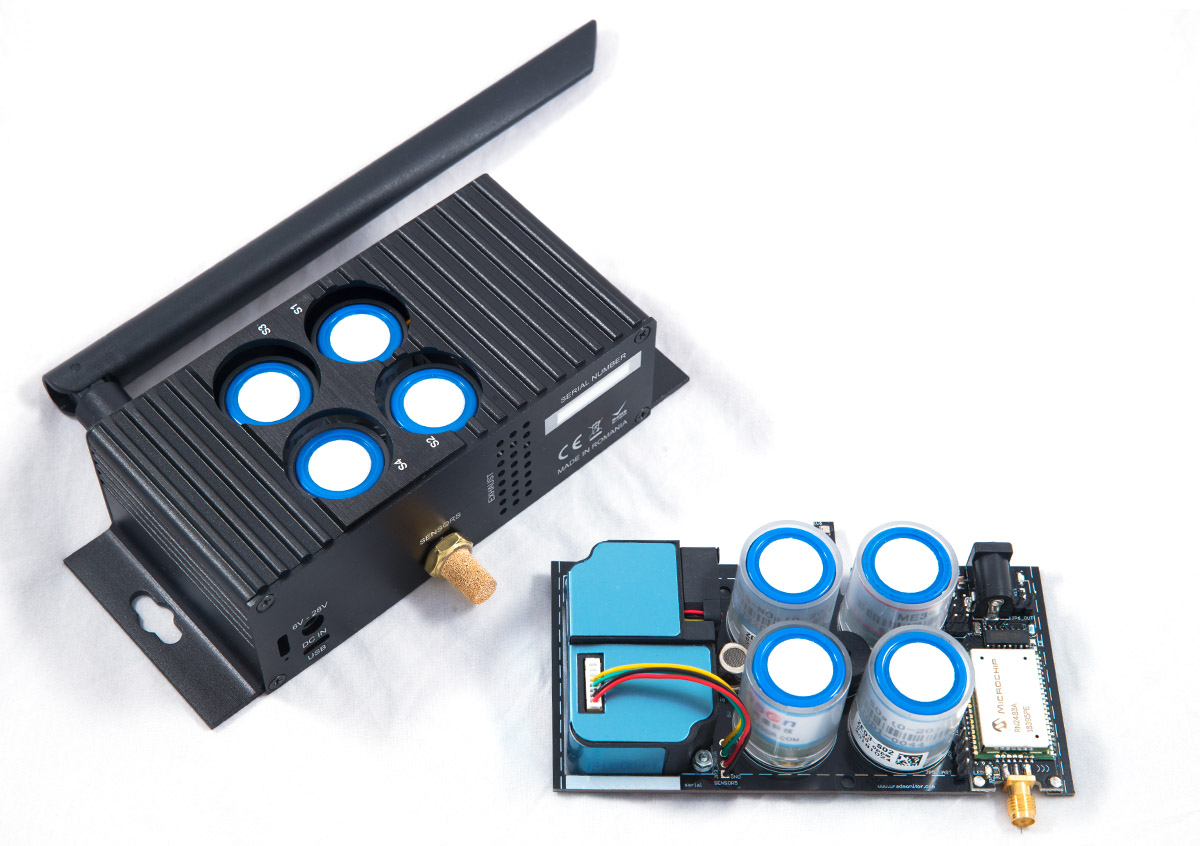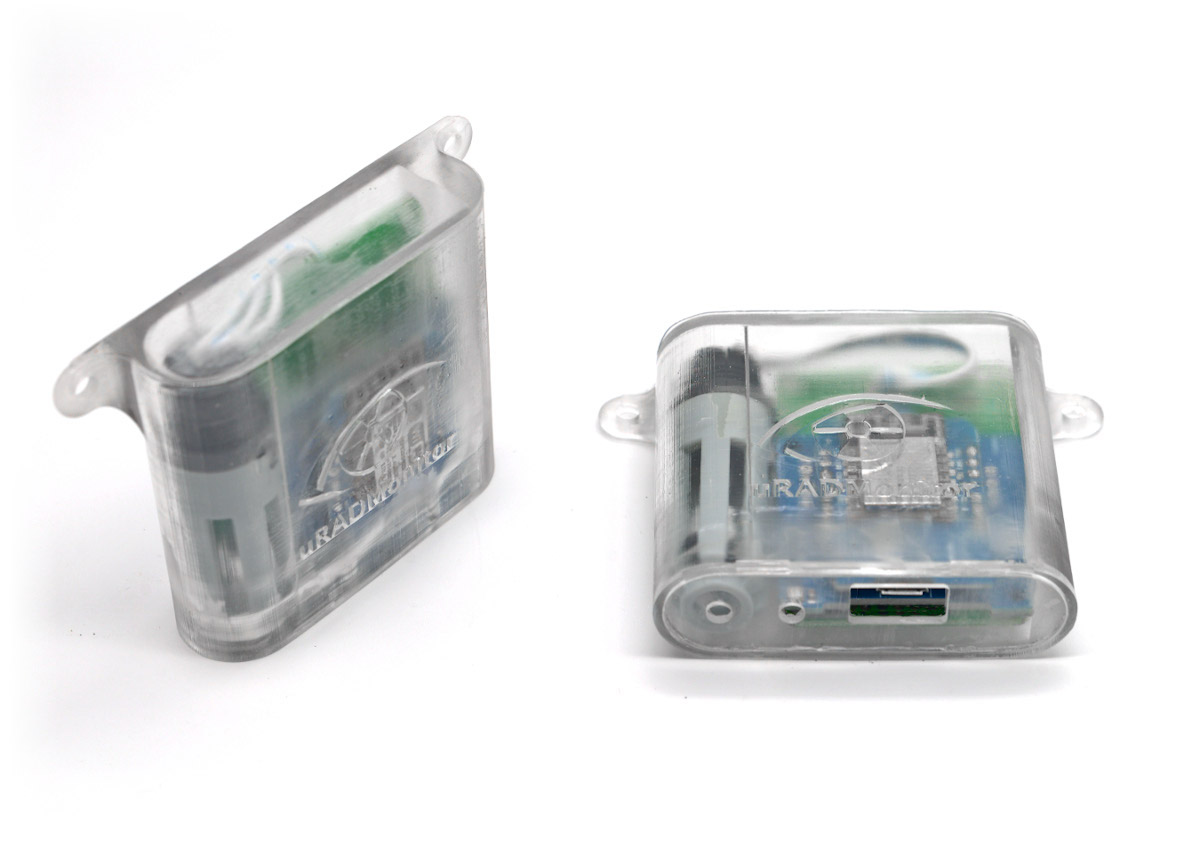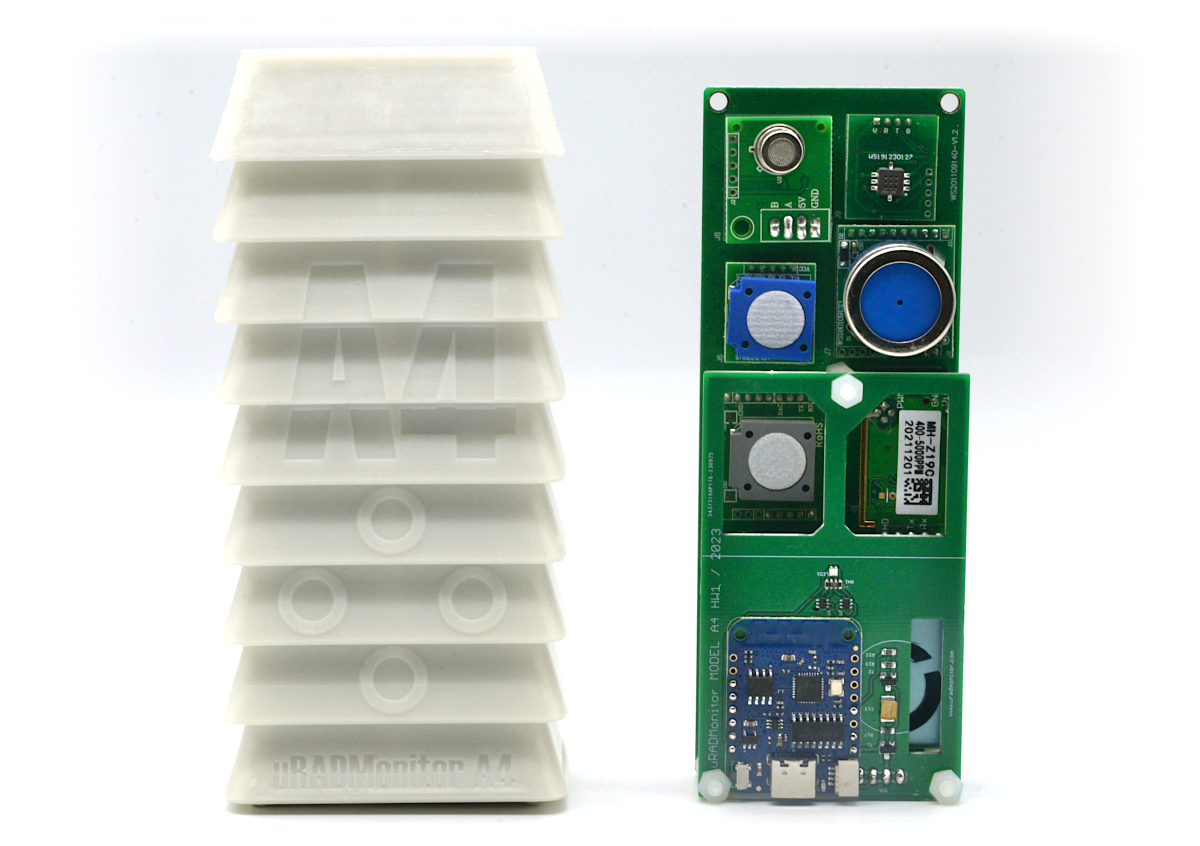MODEL A3Contact us
Plug and play advanced air quality monitoring station, enclosed in an aluminium body for rugged design, it has sensors for Particulate Matter (PM2.5, PM1, PM10), Ozone, Formaldehyde, Carbon Dioxide, Volatile Organic Compounds (VOC), temperature, barometric pressure, air humidity and noise. The A3 comes in 4 variants with connectivity options: Ethernet, Wifi, GSM (with a data sim card) and LoraWAN. This monitor is lab tested for data accuracy.
Pat, UK: "So impressed with all your work, and a bit jealous of your talents!"
uRADMonitor model A3 uses a MEMs sensor to measure air temperature and humidity. A MOX VOC sensor measures volatile organic compounds. A high quality laser scattering sensor is used to detect the Particulate Matter PM2.5 concentration in air. There are two electrochemical sensors, one for formaldehyde sensor and another one for ozone and a nondispersive infrared sensor for CO2. A built in fan assures an active air flow stream across the sensing elements. There is also a noise level sensor.
* VOC concentration interval is estimated for alcohol.
To see complete specs see the technical datasheet.
| Sensor | Parameter | Minimum value | Maximum value |
| MEMs | Temperature | -40 °C | +85 °C |
| Humidity | 0% RH | 100% RH | |
| Laser scattering | PM1.0 | 0 μg/m³ | 1000 μg/m³ |
| PM2.5 | 0 μg/m³ | 1000 μg/m³ | |
| PM10 | 0 μg/m³ | 1000 μg/m³ | |
| Electrochemical | Formaldehyde | 0 ppm | 5 ppm |
| Electrochemical | Ozone | 0 ppm | 10 ppm |
| NDIR | Carbon Dioxide | 400 ppm | 5000 ppm |
| MOX | VOC | 10 ppm | 1000 ppm * |
| Analogue sound sensor | Noise level | 30dB | 130dB |
To see complete specs see the technical datasheet.
Many of the pollutants measured by Model A3 can have a negative impact on our health, ranging from simple allergies to various cancers. Therefore the data gathered by this device is valuable for our understanding on the quality of our
environment.

Picture: uRADMonitor fights pollution to improve our health
VOC or volatile organic compounds are a class of substances that evaporate at room temperature. Being different
substances may be responsible for a broad category of disorders, including respiratory problems, allergic or weakening
immunity in children. Some VOC ‘s are responsible for the formation of smog, irritation of eyes, nose and throat,
headaches and concentration problems. In extreme circumstances, more severe complications can occur, such as
damage to liver, kidney and central nervous system or cancer [1]
Particulate matter PM2.5 refers to small particles with a diameter of up to 2.5 microns. These particles can penetrate deep into the lungs , causing allergies, respiratory and cardiovascular diseases [2]
Formaldehyde is a toxic colorless gas with a pungent smell, that results from the burning of carbon based materials. It can be found in forest fires, in automobile exhaust and cigarette smoke. It is an allergenic and a known carcinogenic compound that can cause serious health effects, depending on concentration and exposure. Even in tiny quantities just above 0.1ppm it can irritate the eyes and nose, and can worsen asthma symptoms [3]
Carbon dioxide is a gas heavier than air. In small quantities of up to 5000ppm (0.5% ) can cause headaches, lethargy, slowing of intellectual ability, irritability, sleep disturbance. In larger quantities can cause dizziness, loss of sight, hearing or knowledge. The fresh air contains between 360ppm and 410 ppm of CO2 [4]
Ozone can cause the muscles in the airways to constrict, trapping air in the alveoli. This leads to wheezing and shortness of breath. Long-term exposure to ozone is linked to aggravation of asthma, and is likely to be one of many causes of asthma development. Long-term exposures to higher concentrations of ozone may also be linked to permanent lung damage, such as abnormal lung development in children. [5]
Noise Induced Hearing Loss (NIHL) is the most common and often discussed health effect, but research has shown that exposure to constant or high levels of noise can cause countless adverse health affects. [6]
[1] Volatile Organic Compounds’ Impact on Indoor Air Quality, US Environmental Protection Agency
[2] Health and Environmental Effects of Particulate Matter (PM), US Environmental Protection Agency
[3] ToxFAQs™ for Formaldehyde, Agency for Toxic Substances and Disease Registry
[4] Effects of low-level inhalation exposure to carbon dioxide in indoor environments
[5] Health Effects of Ozone Pollution, US Environmental Protection Agency
[6] Noise Pollution, US Environmental Protection Agency

Particulate matter PM2.5 refers to small particles with a diameter of up to 2.5 microns. These particles can penetrate deep into the lungs , causing allergies, respiratory and cardiovascular diseases [2]
Formaldehyde is a toxic colorless gas with a pungent smell, that results from the burning of carbon based materials. It can be found in forest fires, in automobile exhaust and cigarette smoke. It is an allergenic and a known carcinogenic compound that can cause serious health effects, depending on concentration and exposure. Even in tiny quantities just above 0.1ppm it can irritate the eyes and nose, and can worsen asthma symptoms [3]
Carbon dioxide is a gas heavier than air. In small quantities of up to 5000ppm (0.5% ) can cause headaches, lethargy, slowing of intellectual ability, irritability, sleep disturbance. In larger quantities can cause dizziness, loss of sight, hearing or knowledge. The fresh air contains between 360ppm and 410 ppm of CO2 [4]
Ozone can cause the muscles in the airways to constrict, trapping air in the alveoli. This leads to wheezing and shortness of breath. Long-term exposure to ozone is linked to aggravation of asthma, and is likely to be one of many causes of asthma development. Long-term exposures to higher concentrations of ozone may also be linked to permanent lung damage, such as abnormal lung development in children. [5]
Noise Induced Hearing Loss (NIHL) is the most common and often discussed health effect, but research has shown that exposure to constant or high levels of noise can cause countless adverse health affects. [6]
[1] Volatile Organic Compounds’ Impact on Indoor Air Quality, US Environmental Protection Agency
[2] Health and Environmental Effects of Particulate Matter (PM), US Environmental Protection Agency
[3] ToxFAQs™ for Formaldehyde, Agency for Toxic Substances and Disease Registry
[4] Effects of low-level inhalation exposure to carbon dioxide in indoor environments
[5] Health Effects of Ozone Pollution, US Environmental Protection Agency
[6] Noise Pollution, US Environmental Protection Agency
The model A3 is designed as an automated, fixed, Air Quality monitoring station. The A3 is IOT and it comes in 4 variants, with the same sensors but offering different connectivity options: Ethernet, Wifi, GSM/GPRS and LoraWAN. It takes any voltage in the 6V - 28V interval and uses less than 1 Watt of power to run. A built in speaker can provide audible notifications, configurable via the dashboard. This unit doesn't have a screen, it works as a monitor and the data can be viewed remotely on a computer or on a mobile device.
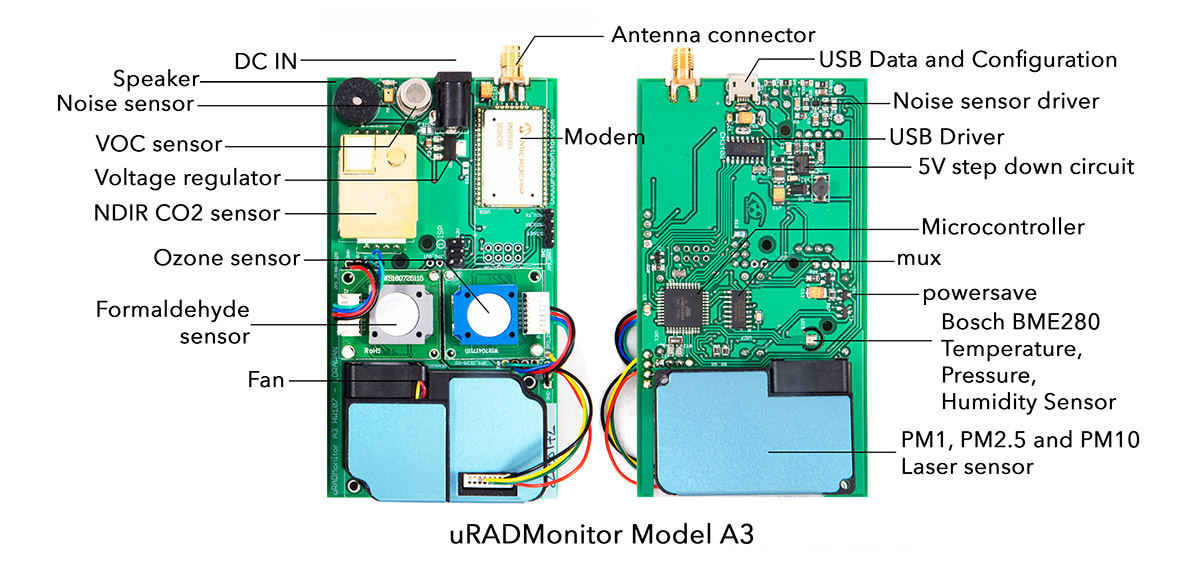
Picture: uRADMonitor A3 motherboard front and bottom view

| Item | Parameter | Ratings |
| Voltage | External | 6V - 28V |
| Connectivity | 4 options | Ethernet, WiFi, GSM, LoRaWAN |
| Microcontroller | Atmega1284p | 8 bit |
| Enclosure | Rugged aluminium | 110x80x24 mm |
Your uRADMonitor unit can be mounted both indoors and outdoors, but not directly exposed to sun, to avoid overheating in warmer areas. A covered spot with some shadow if installed in the free air, is ideal. The unit has a rugged aluminium enclosure that is not rainproof due to the air vents. Make sure that nothing is blocking the air vents. The enclosure has wall-mounting brackets, making installation easy.
If you have a radio variant with an antenna, connect the antenna first. If it is the wired variant, connect it to the Internet Router using the Ethernet cable. Connect the uRADMonitor to the power source using a DC adapter with voltage between 6V and 28V or via the USB port with a 5V USB adapter.
The Ethernet variant
Make sure the device is connected to the Internet router using the Ethernet cable. Use a longer cable if needed. The Internet router must have DHCP enabled. When powered, the uRADMonitor gets an IP automatically, via DHCP, and will show up on the map automatically.
The WIFI variant
Use a smartphone or a computer with WLAN capabilities to connect to the local hotspot spawned by your A3 unit. The SSID is uRADMonitor-XX, where XX are the last two digits of the Device ID number. The key is the Device ID, in uppercase, as printed on the enclosure. Open 192.168.4.1 in your browser, and click the "WIFI" link to setup the connection to the Internet AP. Enter the SSID and key of your Internet Access Point. If the connection fails, you will see the status message, and three consecutive beeps will indicated the problem. Alternatively you can change the configuration using the USB data port. See the USB manual.
The LORAWAN variant
Your device must be pre-provisioned with the LoraWAN Gateway and network server details. Alternativelly you can change the configuration using the USB data port. See the USB manual.
The GSM variant
A data SIM card must be inserted in your A3 unit before it can connect over Internet.
Starting with hardware version HW106, the LoRaWAN, Wifi and GSM settings can be customized via the USB connection. Consult your product manual for complete details.
If you have a radio variant with an antenna, connect the antenna first. If it is the wired variant, connect it to the Internet Router using the Ethernet cable. Connect the uRADMonitor to the power source using a DC adapter with voltage between 6V and 28V or via the USB port with a 5V USB adapter.
The Ethernet variant
Make sure the device is connected to the Internet router using the Ethernet cable. Use a longer cable if needed. The Internet router must have DHCP enabled. When powered, the uRADMonitor gets an IP automatically, via DHCP, and will show up on the map automatically.
The WIFI variant
Use a smartphone or a computer with WLAN capabilities to connect to the local hotspot spawned by your A3 unit. The SSID is uRADMonitor-XX, where XX are the last two digits of the Device ID number. The key is the Device ID, in uppercase, as printed on the enclosure. Open 192.168.4.1 in your browser, and click the "WIFI" link to setup the connection to the Internet AP. Enter the SSID and key of your Internet Access Point. If the connection fails, you will see the status message, and three consecutive beeps will indicated the problem. Alternatively you can change the configuration using the USB data port. See the USB manual.
The LORAWAN variant
Your device must be pre-provisioned with the LoraWAN Gateway and network server details. Alternativelly you can change the configuration using the USB data port. See the USB manual.
The GSM variant
A data SIM card must be inserted in your A3 unit before it can connect over Internet.
Starting with hardware version HW106, the LoRaWAN, Wifi and GSM settings can be customized via the USB connection. Consult your product manual for complete details.
Quick Start
Product Manual
Technical Datasheet
USB Serial Commands Manual
LoRaWAN Data Server Callback manual
Product Limited Warranty terms
uRADMonitor with WIFI Configuration manual
Data access:
Terms of Service
API Terms of Service
API and Server Specs
Direct Data access
Payload Structure (FW78)
Accuracy lab tests and certifications
INCD ECOIND Report (ISO 17025 compliant), for testing the A3 against the reference methods
AQMD AQ-SPEC Performance test report
USB Driver
In their recent versions, Windows, Linux and MacOS come with built in drivers for your uRADMonitor unit. Use the following resources only if the built in drivers do not work for you.
USB Driver for Windows
USB Driver for Linux
USB Driver for MacOS
RO:
RO: Ghid rapid de utilizare
Fisa tehnica
Product Manual
Technical Datasheet
USB Serial Commands Manual
LoRaWAN Data Server Callback manual
Product Limited Warranty terms
uRADMonitor with WIFI Configuration manual
Data access:
Terms of Service
API Terms of Service
API and Server Specs
Direct Data access
Payload Structure (FW78)
Accuracy lab tests and certifications
INCD ECOIND Report (ISO 17025 compliant), for testing the A3 against the reference methods
AQMD AQ-SPEC Performance test report
USB Driver
In their recent versions, Windows, Linux and MacOS come with built in drivers for your uRADMonitor unit. Use the following resources only if the built in drivers do not work for you.
USB Driver for Windows
USB Driver for Linux
USB Driver for MacOS
RO:
RO: Ghid rapid de utilizare
Fisa tehnica
MODEL INDUSTRIALContact us
An automated, fixed monitoring station that tracks a total of 11 important air quality parameters including Particulate Matter, Carbon Monoxide, Ozone, Sulphur Dioxide, Nitrogen Dioxide and more for the INDUSTRIAL sector. It comes in a rugged aluminum enclosure with wall mounting support. The data is exported to the uRADMonitor network with Wifi or LORAWAN, and can be accessed in real time using the cloud API interface or directly via the local network.
John, USA: "It's an impressive bit of hardware. I especially like the "Made in Romania" - slowly collecting things *not* made in China."
uRADMonitor model INDUSTRIAL uses a high quality laser scattering sensor to measure Particulate Matter PM1, PM2.5 and PM10 concentrations in air. Four additional electrochemical sensors measure Carbon Monoxide, Sulphur Dioxide, Nitrogen Dioxide and Ozone by default, interchangeable to support additional gases resulting from production or industrial processes. A MOX VOC sensor measures volatile organic compounds. A built in fan assures an active air flow stream across the sensing elements. The MEMs sensor reads ambient temperature and humidity, and a noise sensor measures the noise level. This product is intended for the industrial sector where medium and high gas concentrations need to be observed.
By the nature of the technology used, any sensor can potentially fail to meet specification without warning. We make every effort to ensure reliability of all sensors but where life safety is a performance requirement of the product and, where practical, we recommend that all gas sensors and instruments using sensors are checked for response to gas before use.
We accept no liability for any consequential losses, injury or damage resulting from the use of the uRADMonitor products. Customers should test the sensors under their own conditions to ensure that the sensors are suitable for their own requirements and in accordance with the plans and circumstances of the specified project and any standards / regulations pertaining to the country in which the sensors will be utilized.
Notes:
Only sensors marked in green are currently available.
All sensors are individually tested and calibrated.
| Sensor | Parameter | Minimum value | Maximum value |
| MEMs | Temperature | -40 °C | +85 °C |
| Humidity | 0% RH | 100% RH | |
| Laser scattering | PM1.0 | 0 μg/m³ | 1000 μg/m³ |
| PM2.5 | 0 μg/m³ | 1000 μg/m³ | |
| PM10 | 0 μg/m³ | 1000 μg/m³ | |
| MOX | VOC | 10 ppm | 1000 ppm * |
| Analogue sound sensor | Noise level | 30dB | 130dB |
| Electrochemical | Ozone | 0 ppm | 10 ppm |
| Electrochemical | Nitrogen Dioxide | 0 ppm | 10 ppm |
| Electrochemical | Sulphur Dioxide | 0 ppm | 20 ppm |
| Electrochemical | Carbon Monoxide | 0 ppm | 200 ppm |
Custom gases detection options
* The unit comes with Ozone, Nitrogen Dioxide, Sulphur Dioxide and Carbon Monoxide calibrated electrochemical sensors built in. These 4 sensors, can be replaced with any combination of sensors for the below gases and ranges. In some situations we can offer custom detection intervals (eg. 0-1000ppm for CO, etc):| Symbol | Gas | Detection interval |
| CO | Carbon monoxide | 0 - 200ppm |
| O2 | Oxigen | 0 - 25%VOL |
| NH3 | Ammonia gas | 0 - 100ppm |
| H2S | Hydrogen sulfide | 0 - 100ppm |
| SO2 | Sulfur dioxide | 0 - 20ppm |
| NO2 | Nitrogen dioxide | 0 - 10ppm |
| Cl2 | Chlorine gas | 0 - 20ppm |
| O3 | Ozone | 0 - 10ppm |
| H2 | Hydrogen gas | 0 - 1000ppm |
| HF | Hydrogen fluoride | 0 - 10ppm |
| C2H4 | Ethylene | 0 - 100ppm |
| CH2O | Formaldehyde | 0 - 10ppm |
| ETO | Ethylene oxide | 0 - 20ppm |
| HCl | Hydrogen chloride | 0 - 20ppm |
| C6H6 | Benzene | 0 - 100ppm |
| C7H8 | Toluene | 0 - 500ppm |
| C2H3Cl | Vinyl chloride | 0 - 20ppm |
| C2H6S | Methyl Sulfide | 0 - 100ppm |
| C2H6S2 | Dimethyl Disulfide | 0 - 100ppm |
| AsH3 | Arsine | 0 - 3ppm |
| C3H9N | Trimethylamine | 0 - 100ppm |
| C8H8 | Styrene | 0 - 100ppm |
| CH4S | Methanethiol | 0 - 100ppm |
| CS2 | Carbon Disulfide | 0 - 100ppm |
| PH3 | Phosphine | 0 - 10ppm |
| HCN | Hydrogen cyanide | 0 - 100ppm |
Air pollution is the single largest environmental cause of premature death in urban Europe and transport is the main source. The 2008 Air Quality Directive, now under review, obliges member states to cut exposure to fine particulate matter by an average of 20% by 2020, based on 2010 levels.
The National Emissions Ceiling Directive caps some emissions including particulate matter (PM) and nitrogen dioxide (NOx) at national level. A revised version of the directive is as of 2016 under scrutiny by the Council of Ministers and European Parliament. Across the EU in 2013, nitrogen dioxide (NO2), which is mostly produced by traffic, caused 68,000 premature deaths. The Dieselgate scandal exposed how Volkswagen had gamed NO2 emissions tests.
Ozone (O3) killed 16,000 and small particulate matter (PM2.5) caused 436,000 deaths in the same year. PM2.5 particles, microscopic specks of dust and soot caused by burning fossil fuels, can enter the lungs and bloodstream.
 Air pollution has different particulate matter (PM) components – smoke, dirt and dust form coarse particles known as PM10 and metals and toxic exhaust from smelting, vehicle exhaust, power plants and refuse burning forming fine particles called PM2.5.
Air pollution has different particulate matter (PM) components – smoke, dirt and dust form coarse particles known as PM10 and metals and toxic exhaust from smelting, vehicle exhaust, power plants and refuse burning forming fine particles called PM2.5.
uRADMonitor INDUSTRIAL is intended for the industrial sector where medium and high gas concentrations need to be observed.
The National Emissions Ceiling Directive caps some emissions including particulate matter (PM) and nitrogen dioxide (NOx) at national level. A revised version of the directive is as of 2016 under scrutiny by the Council of Ministers and European Parliament. Across the EU in 2013, nitrogen dioxide (NO2), which is mostly produced by traffic, caused 68,000 premature deaths. The Dieselgate scandal exposed how Volkswagen had gamed NO2 emissions tests.
Ozone (O3) killed 16,000 and small particulate matter (PM2.5) caused 436,000 deaths in the same year. PM2.5 particles, microscopic specks of dust and soot caused by burning fossil fuels, can enter the lungs and bloodstream.
 Air pollution has different particulate matter (PM) components – smoke, dirt and dust form coarse particles known as PM10 and metals and toxic exhaust from smelting, vehicle exhaust, power plants and refuse burning forming fine particles called PM2.5.
Air pollution has different particulate matter (PM) components – smoke, dirt and dust form coarse particles known as PM10 and metals and toxic exhaust from smelting, vehicle exhaust, power plants and refuse burning forming fine particles called PM2.5.uRADMonitor INDUSTRIAL is intended for the industrial sector where medium and high gas concentrations need to be observed.
The model INDUSTRIAL is designed as a fixed monitoring station. It comes in 2 variants, with the same sensors but offering different connectivity options: Wifi and LoraWAN. It takes any voltage in the 6V - 24V interval and uses less than 1 Watt of power to run. It can be powered using a small solar panel making it the perfect remote surveillance monitor. This unit doesn't have a screen, it works as a monitor and the data can be viewed remotely on a computer or on a mobile device.
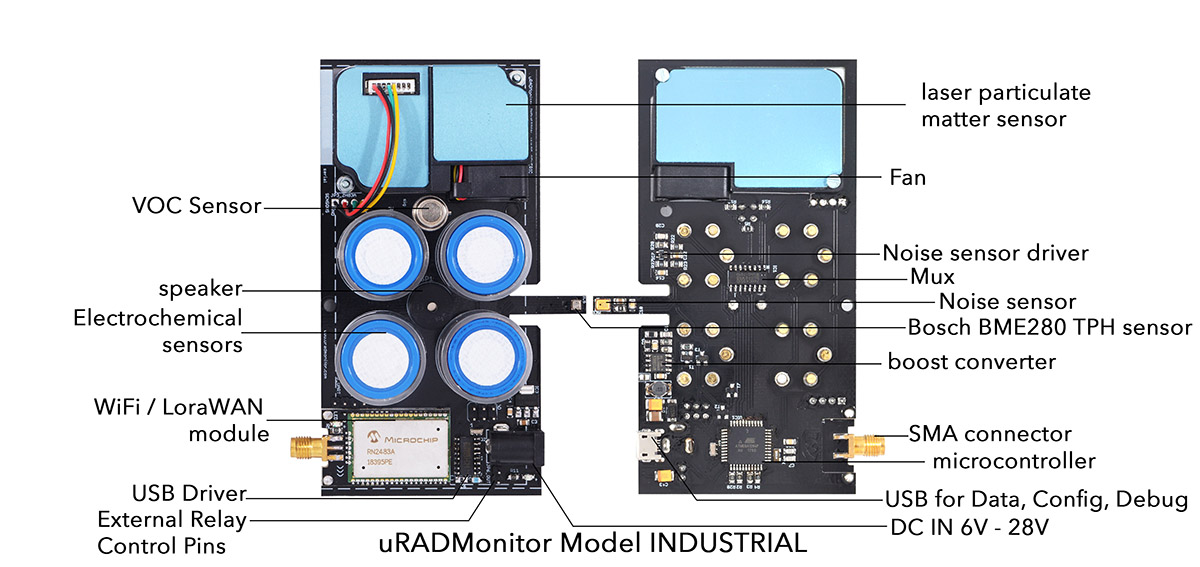
Picture: uRADMonitor INDUSTRIAL motherboard front and bottom view

| Item | Parameter | Ratings |
| Voltage | External | 6V - 24V |
| Connectivity | 4 options | WiFi, LoRaWAN, USB |
| Microcontroller | Atmega1284p | 8 bit |
Your uRADMonitor unit can be mounted both indoors and outdoors, but not directly exposed to sun, to avoid overheating in warmer areas. A covered spot with some shadow if installed in the free air, is ideal. The unit has a rugged aluminium enclosure that is not rainproof due to the air vents. Make sure that nothing is blocking the air vents. The enclosure has wall-mounting brackets, making installation easy.
If you have a radio variant with an antenna, connect the antenna first. Next, connect the uRADMonitor to the power source using a DC adapter with voltage between 6V and 24V. Connect the uRADMonitor to the power source using a DC adapter with voltage between 6V and 24V or via the USB port with a 5V USB adapter.
The WIFI variant
Use a smartphone or a computer with WLAN capabilities to connect to the local hotspot spawned by your unit. The SSID is uRADMonitor-XX, where XX are the last two digits of the Device ID number. The key is the Device ID, in uppercase, as printed on the enclosure. Open 192.168.4.1 in your browser, and click the "WIFI" link to setup the connection to the Internet AP. Enter the SSID and key of your Internet Access Point. If the connection fails, you will see the status message, and three consecutive beeps will indicated the problem. Alternatively you can change the configuration using the USB data port. See the USB manual.
The LORAWAN variant
Your device must be pre-provisioned with the LoraWAN Gateway and network server details. Alternativelly you can change the configuration using the USB data port. See the USB manual.
The device comes with an USB port, so the configuration settings can be customized via the USB connection. Consult your product manual for complete details.
If you have a radio variant with an antenna, connect the antenna first. Next, connect the uRADMonitor to the power source using a DC adapter with voltage between 6V and 24V. Connect the uRADMonitor to the power source using a DC adapter with voltage between 6V and 24V or via the USB port with a 5V USB adapter.
The WIFI variant
Use a smartphone or a computer with WLAN capabilities to connect to the local hotspot spawned by your unit. The SSID is uRADMonitor-XX, where XX are the last two digits of the Device ID number. The key is the Device ID, in uppercase, as printed on the enclosure. Open 192.168.4.1 in your browser, and click the "WIFI" link to setup the connection to the Internet AP. Enter the SSID and key of your Internet Access Point. If the connection fails, you will see the status message, and three consecutive beeps will indicated the problem. Alternatively you can change the configuration using the USB data port. See the USB manual.
The LORAWAN variant
Your device must be pre-provisioned with the LoraWAN Gateway and network server details. Alternativelly you can change the configuration using the USB data port. See the USB manual.
The device comes with an USB port, so the configuration settings can be customized via the USB connection. Consult your product manual for complete details.
Quick Start
Technical Datasheet
USB Serial Commands Manual
LoRaWAN Data Server Callback manual
Product Limited Warranty terms
uRADMonitor with WIFI Configuration manual
Data access:
Terms of Service
API Terms of Service
API and Server Specs
Direct Data access
Payload Structure (FW78)
USB Driver
In their recent versions, Windows, Linux and MacOS come with built in drivers for your uRADMonitor unit. Use the following resources only if the built in drivers do not work for you.
USB Driver for Windows
USB Driver for Linux
USB Driver for MacOS
RO:
Fisa tehnica
Technical Datasheet
USB Serial Commands Manual
LoRaWAN Data Server Callback manual
Product Limited Warranty terms
uRADMonitor with WIFI Configuration manual
Data access:
Terms of Service
API Terms of Service
API and Server Specs
Direct Data access
Payload Structure (FW78)
USB Driver
In their recent versions, Windows, Linux and MacOS come with built in drivers for your uRADMonitor unit. Use the following resources only if the built in drivers do not work for you.
USB Driver for Windows
USB Driver for Linux
USB Driver for MacOS
RO:
Fisa tehnica
MODEL BUZZContact us
Industrial grade Noise meter with a WIFI connection to report sound level measurements in real time. The data can be accessed via the API interface or directly via the local network.
Brad, Canada: "I would like to congratulate all in the effort to bring this to life, and how far it has come."
BUZZ combines a digital noise sensor with a WIFI connectivity module to give you real time noise monitoring. It is an industrial grade noise meter that can be used both at indoors and outdoors.
To see complete specs see the technical datasheet.
| Sensor | Parameter | Minimum value | Maximum value |
| MEMS | Temperature | -40 °C | +125 °C |
| Humidity | 0% RH | 100% RH | |
| SM7901 | Noise | 30 dB | 130 dB |
BUZZ can help you monitor noise levels in your company or production facility. Noise Induced Hearing Loss (NIHL) is the most common and often discussed health effect, but research has shown that exposure to constant or high levels of noise can cause countless adverse health affects. [1]

Picture: uRADMonitor does real time environmental monitoring
[1] Noise Pollution, US Environmental Protection Agency

| Item | Parameter | Ratings |
| Voltage | External | 5V micro-USB |
| Consumption | Current | 50mA |
| Connectivity | Internet | Wifi |
| Microcontroller | ESP8266 | 8 bit |
| Enclosure | Rainproof plastic | 85x44x20 mm |
Your uRADMonitor unit can be mounted both indoors and outdoors .For mounting, use the two holes in the housing. Ensure that you properly connect the power cord and secure it against vibration where necessary. If your BUZZ has a transparent resin case, screw carefully because the case is brittle. The distance between the center of the fixing holes is 75mm.
Quick Setup
Connect it to power using a 5V micro-USB cable. Use a smartphone or a computer with WLAN capabilities to connect to the local hotspot spawned by your BUZZ unit. The SSID is uRADMonitor-XX, where XX are the last two digits of the Device ID number. The key is the Device ID, in uppercase, as printed on the enclosure. Open 192.168.4.1 in your browser, and click the "WIFI/CONFIG" link to setup the connection to the Internet AP. Enter the SSID and key of your Internet Access Point. If the connection fails, you will see the status message.
USB configuration
Alternatively, the SSID and KEY can also be configured via USB. Connect to your BUZZ via USB, baudrate 9600bps, open a terminal program and type the two commands: "key1","SSID" then "key2","your WLAN key" . Use the "getsettings" command to verify that the new settings are in place. Quotes are a must, and there are no spaces in between. See the USB Commands manual for more. See the USB Commands manual if you need more help.
Quick Setup
Connect it to power using a 5V micro-USB cable. Use a smartphone or a computer with WLAN capabilities to connect to the local hotspot spawned by your BUZZ unit. The SSID is uRADMonitor-XX, where XX are the last two digits of the Device ID number. The key is the Device ID, in uppercase, as printed on the enclosure. Open 192.168.4.1 in your browser, and click the "WIFI/CONFIG" link to setup the connection to the Internet AP. Enter the SSID and key of your Internet Access Point. If the connection fails, you will see the status message.
USB configuration
Alternatively, the SSID and KEY can also be configured via USB. Connect to your BUZZ via USB, baudrate 9600bps, open a terminal program and type the two commands: "key1","SSID" then "key2","your WLAN key" . Use the "getsettings" command to verify that the new settings are in place. Quotes are a must, and there are no spaces in between. See the USB Commands manual for more. See the USB Commands manual if you need more help.
Quick Start
Technical Datasheet
USB Serial Commands Manual
API and Server Specs
Product Limited Warranty terms
Decentralized unit use for direct data access
uRADMonitor with WIFI Configuration manual
RO: Ghid rapid de utilizare
RO: conditii generale de utilizare
USB Driver
In their recent versions, Windows, Linux and MacOS come with built in drivers for your uRADMonitor unit. Use the following resources only if the built in drivers do not work for you.
USB Driver for Windows
USB Driver for Linux
USB Driver for MacOS
Technical Datasheet
USB Serial Commands Manual
API and Server Specs
Product Limited Warranty terms
Decentralized unit use for direct data access
uRADMonitor with WIFI Configuration manual
RO: Ghid rapid de utilizare
RO: conditii generale de utilizare
USB Driver
In their recent versions, Windows, Linux and MacOS come with built in drivers for your uRADMonitor unit. Use the following resources only if the built in drivers do not work for you.
USB Driver for Windows
USB Driver for Linux
USB Driver for MacOS
MODEL A4Contact us
Multiparameter advanced air quality monitoring station, in a rainproof enclosure for both outdoor and indoor use. Contains 8 individual sensors to track Temperature, Relative Humidity, Nitrogen Dioxide, Formaldehyde, Carbon Monoxide, Ozone, Carbon Dioxide, Particulate Matter PM1, PM2.5, PM10 and Volatile Organic Compounds (VOC). Modular design that saves costs. Stevenson shield included, ready for outdoor use!
Andrei A., Romania: The most accurate and widespread air quality monitoring network. I also own several of their sensors and all work flawlessly.
uRADMonitor model A4 uses a MEMs sensor to measure air temperature and humidity. A MOX VOC sensor measures volatile organic compounds. Another MEMs sensor measures Nitrogen Dioxide (NO2) .
A high quality laser scattering sensor is used to detect the Particulate Matter PM1 / PM2.5 and PM10 mass concentration in air. There are three electrochemical sensors, one for formaldehyde (CH2O), another one for Ozone (O3) and one for Carbon Monoxide (CO). A nondispersive infrared sensor for CO2.
Everything is encapsulated under a high quality Stevenson Shield ready for outdoor use.
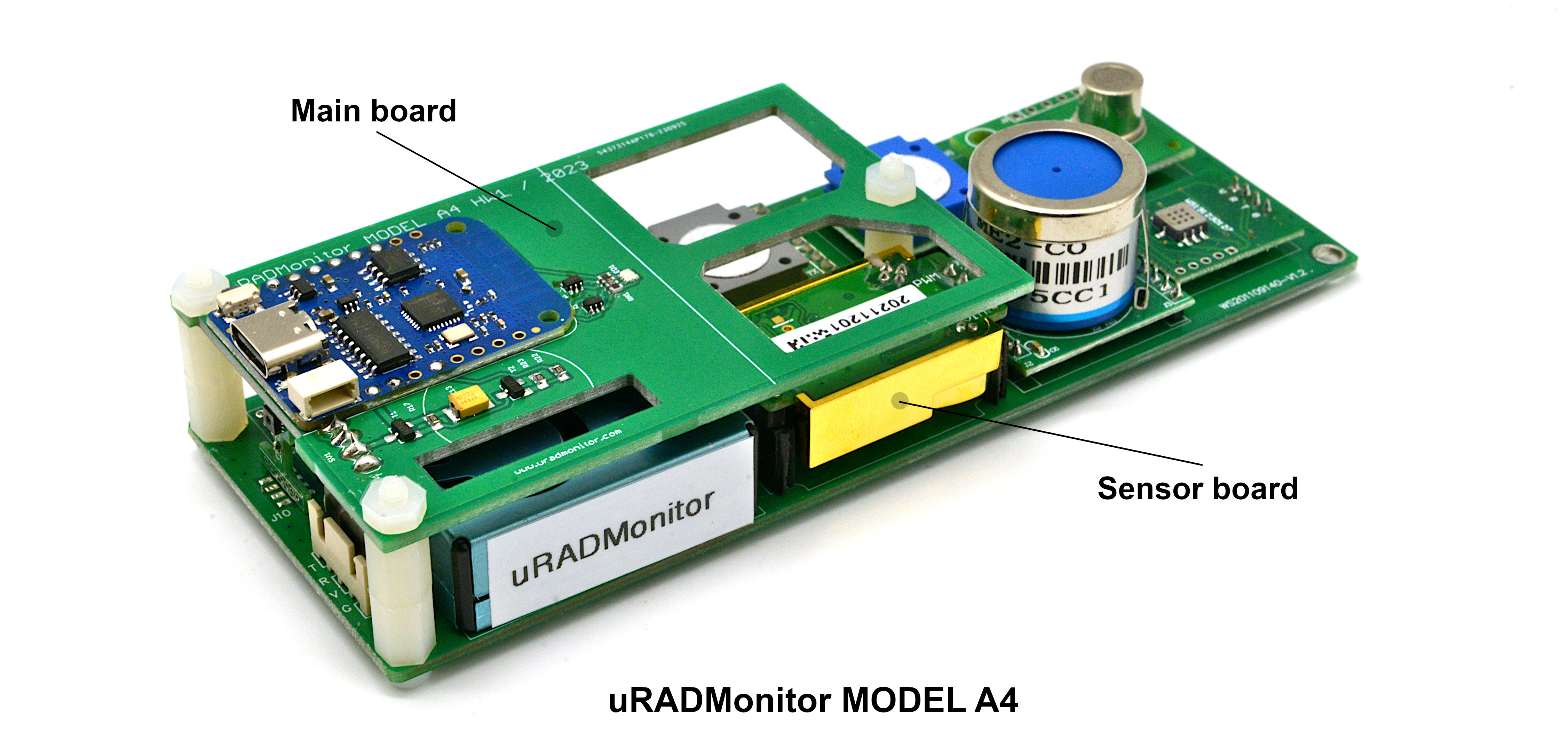
Picture: uRADMonitor A4 has a modular design with sensors on a separate board that can be replaced all together easily
* VOC concentration is provided as a simple score 0 - 3 to reflect air quality
Model A4 is a cost effective multiparameter automated monitor containing 8 high quality digital sensors that track a total of 11 air parameters. It has the capacity to fully characterize the ambient air in regards to health impact based on the major widespread pollutants.

| Sensor | Parameter | Minimum value | Maximum value |
| MEMs | Temperature | -20 °C | +65 °C |
| Humidity | 0% RH | 100% RH | |
| Laser scattering | PM1.0 | 0 μg/m³ | 1000 μg/m³ |
| PM2.5 | 0 μg/m³ | 1000 μg/m³ | |
| PM10 | 0 μg/m³ | 1000 μg/m³ | |
| MEMs | Nitrogen Dioxide | 0 ppm | 10 ppm |
| Electrochemical | Formaldehyde | 0 ppm | 5 ppm |
| Electrochemical | Ozone | 0 ppm | 10 ppm |
| Electrochemical | Carbon Monoxide | 0 ppm | 500 ppm |
| NDIR | Carbon Dioxide | 400 ppm | 5000 ppm |
| MOX | VOC | 0 | 3 * |
Model A4 is a cost effective multiparameter automated monitor containing 8 high quality digital sensors that track a total of 11 air parameters. It has the capacity to fully characterize the ambient air in regards to health impact based on the major widespread pollutants.
Your uRADMonitor unit can be mounted both indoors and outdoors. Its enclosure offers protection to the elements, including sun, rain and snow. A covered spot with some shadow if installed in the free air, is ideal. The stevenson shield enclosure has large air vents, make sure that nothing is blocking them and air can circulate freely. The enclosure has pole / wall-mounting brackets, making installation easy.
Connect the uRADMonitor to the power source using the USB-C cable and the provided USB 5V Adaper.
uRADMonitor Model A4 Works via WIFI
Use a smartphone or a computer with WLAN capabilities to connect to the local hotspot spawned by your A4 unit. The SSID is uRADMonitor-XX, where XX are the last two digits of the Device ID number. The key is the "uradmonitor", in lowercase and without the quotes. You can change this default password later on. Open 192.168.4.1 in your browser, and click the "CONFIG" link to setup the connection to the Internet AP. Enter the SSID and key of your Internet Access Point. If the connection fails, you will see the status message, and three consecutive beeps will indicated the problem. Alternatively you can change the configuration using the USB data port. See the USB manual.
Remember, the Wifi settings can be customized via the USB connection. Consult your product manual for complete details.
Connect the uRADMonitor to the power source using the USB-C cable and the provided USB 5V Adaper.
uRADMonitor Model A4 Works via WIFI
Use a smartphone or a computer with WLAN capabilities to connect to the local hotspot spawned by your A4 unit. The SSID is uRADMonitor-XX, where XX are the last two digits of the Device ID number. The key is the "uradmonitor", in lowercase and without the quotes. You can change this default password later on. Open 192.168.4.1 in your browser, and click the "CONFIG" link to setup the connection to the Internet AP. Enter the SSID and key of your Internet Access Point. If the connection fails, you will see the status message, and three consecutive beeps will indicated the problem. Alternatively you can change the configuration using the USB data port. See the USB manual.
Remember, the Wifi settings can be customized via the USB connection. Consult your product manual for complete details.
Quick Start
Technical Datasheet
USB Serial Commands Manual
LoRaWAN Data Server Callback manual
Product Limited Warranty terms
uRADMonitor with WIFI Configuration manual
Data access:
Terms of Service
API Terms of Service
API and Server Specs
Direct Data access
USB Driver
In their recent versions, Windows, Linux and MacOS come with built in drivers for your uRADMonitor unit. Use the following resources only if the built in drivers do not work for you.
USB Driver for Windows
USB Driver for Linux
USB Driver for MacOS
RO:
RO: Ghid rapid de utilizare
Technical Datasheet
USB Serial Commands Manual
LoRaWAN Data Server Callback manual
Product Limited Warranty terms
uRADMonitor with WIFI Configuration manual
Data access:
Terms of Service
API Terms of Service
API and Server Specs
Direct Data access
USB Driver
In their recent versions, Windows, Linux and MacOS come with built in drivers for your uRADMonitor unit. Use the following resources only if the built in drivers do not work for you.
USB Driver for Windows
USB Driver for Linux
USB Driver for MacOS
RO:
RO: Ghid rapid de utilizare
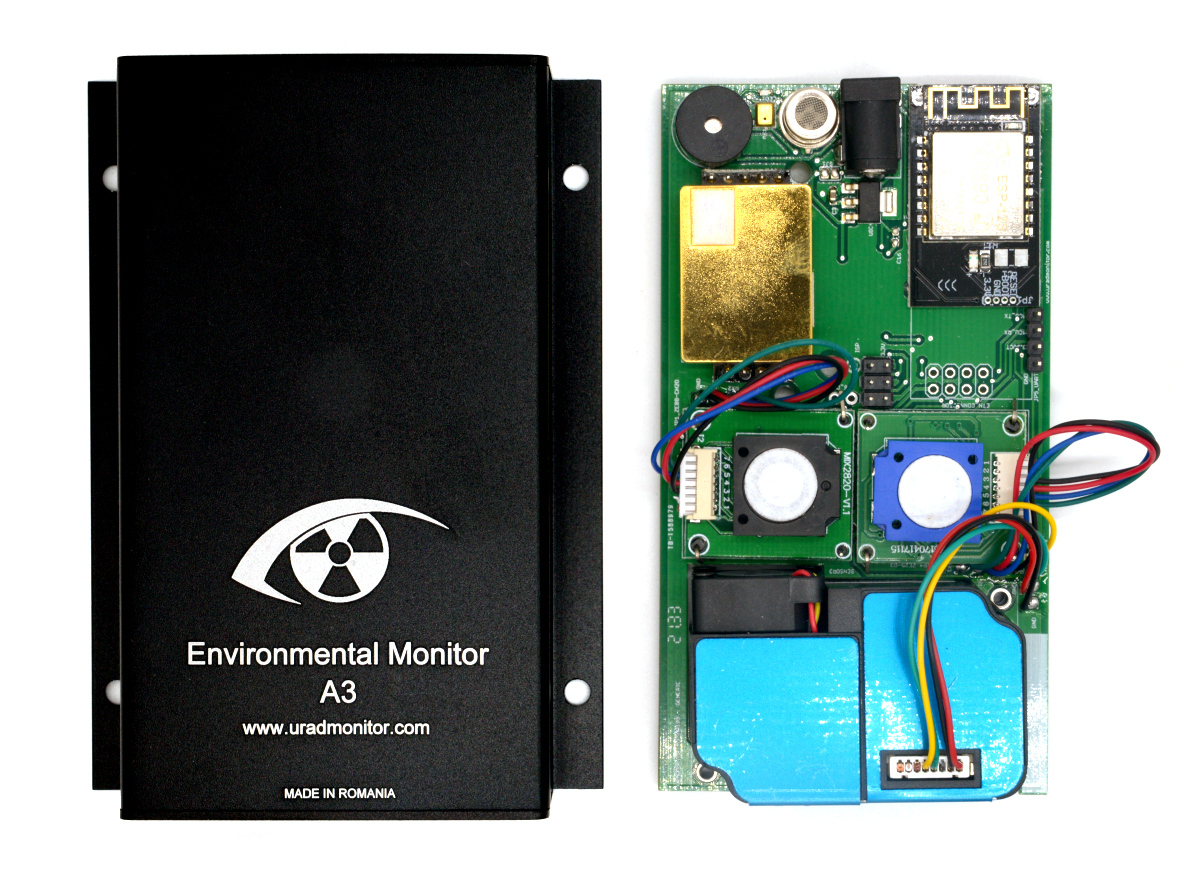
 Available, limited stock.
Available, limited stock.